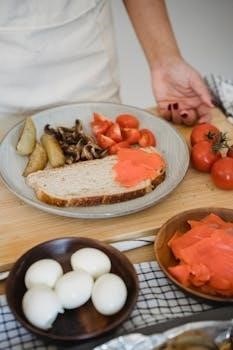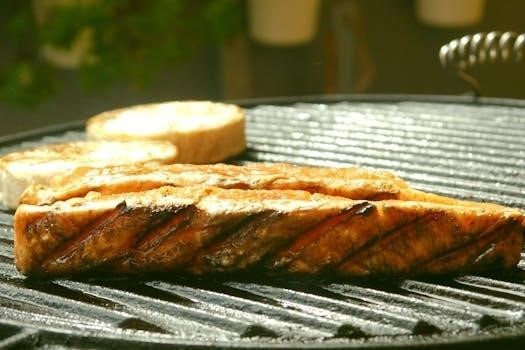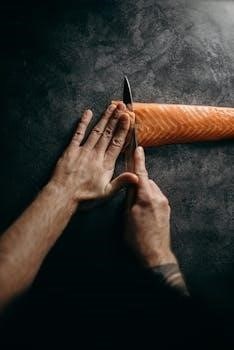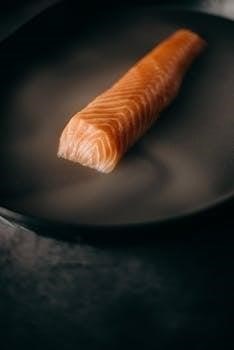Costco Stuffed Salmon⁚ Essential Cooking Instructions
To properly cook your Costco stuffed salmon‚ preheat your oven to 350 degrees Fahrenheit. Ensure the salmon reaches an internal temperature of 145°F‚ which can take around 25-35 minutes. Use a baking tray for safety and check for doneness after 20 minutes.
Preheating the Oven
Before embarking on the culinary journey of cooking Costco’s stuffed salmon‚ preheating your oven is a fundamental step to ensure even and thorough cooking. This initial stage is crucial for achieving the desired texture and flavor of the salmon. The recommended temperature for preheating is typically 350 degrees Fahrenheit (175 degrees Celsius)‚ a setting that allows the salmon to cook gently and uniformly‚ preventing the outside from overcooking before the inside is properly done. It’s advisable to allow your oven to preheat fully‚ which may take approximately 10 to 15 minutes‚ depending on the oven model. This ensures that the oven is at the required temperature when the salmon is placed inside‚ thus initiating the cooking process immediately and maintaining consistent heat throughout. Using an oven thermometer can be a helpful tool to verify the accuracy of your oven’s temperature setting. Preheating the oven is not just a preliminary step; it’s an essential element in the overall success of cooking your Costco stuffed salmon to perfection. A properly preheated oven guarantees that the salmon will bake evenly‚ resulting in a delicious and satisfying meal.

Recommended Baking Temperature
For baking Costco’s stuffed salmon‚ maintaining the correct oven temperature is absolutely vital to achieve the best results. The generally recommended baking temperature is 350 degrees Fahrenheit (175 degrees Celsius). This moderate heat allows the salmon to cook through evenly without drying out or burning the stuffing. It’s important to ensure that your oven is properly preheated to this temperature before placing the salmon inside. Using an oven thermometer to verify the accuracy of your oven’s temperature is highly advisable‚ as some ovens may fluctuate. A consistent temperature of 350°F will help the salmon cook thoroughly‚ ensuring that the internal temperature reaches the recommended 145 degrees Fahrenheit (63 degrees Celsius)‚ which is essential for food safety. Deviating significantly from this temperature could result in uneven cooking‚ with the exterior either becoming too dry or the interior remaining undercooked. This temperature also helps the stuffing to heat through completely‚ without making it overly soggy. Remember‚ a steady and accurate baking temperature of 350°F is key to a perfectly cooked and delicious stuffed salmon.

Initial Baking Time
The initial baking time for Costco’s stuffed salmon is a crucial factor in achieving a perfectly cooked dish. Generally‚ a baking time of 20 to 25 minutes is recommended when using an oven preheated to 350 degrees Fahrenheit. This timeframe allows the salmon to cook through without becoming overcooked and dry. However‚ it’s essential to note that the exact baking time may vary depending on the thickness of the salmon fillets and the specific characteristics of your oven. It’s wise to start checking for doneness around the 20-minute mark. Pay attention to the salmon’s appearance‚ it should start to turn opaque. If the salmon is particularly thick‚ you might need to extend the cooking time slightly‚ but be careful not to overbake it. Monitoring the fish closely is key for achieving the desired texture and doneness. Remember the initial cooking time is just a guideline‚ and adjustments may be needed based on your specific circumstances. It’s always better to slightly underbake and add a bit of extra time than to overcook and dry out the salmon. The initial baking period sets the foundation for a tasty‚ perfectly cooked meal.
Checking for Doneness
Checking for doneness is a critical step in cooking Costco stuffed salmon to ensure it is safe and enjoyable to eat. There are several reliable methods to verify if the salmon is fully cooked. One of the most common ways is to visually inspect the fish. The salmon should have an opaque appearance‚ meaning it has transitioned from its raw‚ translucent state to a solid‚ cooked color. The flesh should also flake easily when gently probed with a fork. If the salmon resists flaking or still appears glassy‚ it needs more cooking time. Another method involves using a food thermometer to check the internal temperature. The thickest part of the salmon should reach a minimum of 145 degrees Fahrenheit (63 degrees Celsius) to be considered safe to eat‚ according to food safety guidelines. Insert the thermometer into the thickest part of the salmon without touching the bone or stuffing. It is important to note that the stuffing also needs to be heated to a safe temperature‚ so ensuring it is also above 145 degrees Fahrenheit is a good practice. Pay close attention to the visual cues as well as the thermometer reading to ensure you serve a perfectly cooked piece of salmon. Combining the visual and temperature method is the best way to confirm doneness.
Internal Temperature Target
The internal temperature target is a crucial factor when cooking Costco stuffed salmon‚ ensuring both safety and optimal taste. For food safety‚ it’s imperative that the salmon reaches a minimum internal temperature of 145 degrees Fahrenheit (63 degrees Celsius). This guideline is recommended by food safety authorities to eliminate harmful bacteria. Reaching this temperature ensures that the fish is fully cooked and safe to consume. To accurately measure the internal temperature‚ use a reliable food thermometer. Insert the thermometer into the thickest part of the salmon fillet‚ avoiding contact with any bones or stuffing. It’s also wise to check the stuffing temperature‚ as this too should reach at least 145 degrees Fahrenheit to ensure that all components of the stuffed salmon are thoroughly cooked. Some sources suggest a slightly higher temperature of 165 degrees Fahrenheit‚ particularly if you prefer the salmon to be more well-done. However‚ sticking to the 145 degrees Fahrenheit mark will generally give you a moist and flaky result. Remember that the salmon will continue to cook slightly after being removed from the oven‚ so take this into account when checking the temperature. Always verify the temperature in multiple spots to guarantee uniform cooking throughout the fillet‚ as temperature can vary across different parts.
Resting Time After Baking
Resting time after baking is an often-overlooked yet essential step in the cooking process of Costco stuffed salmon. After removing the salmon from the oven‚ it’s crucial to let it rest for a few minutes before serving. This resting period allows the internal temperature to stabilize and the juices within the salmon to redistribute evenly throughout the fillet. This results in a more moist and flavorful end product. Typically‚ a resting time of about 2 to 5 minutes is sufficient. Avoid cutting into the salmon immediately after removing it from the oven‚ as this will cause the flavorful juices to escape‚ leading to a drier texture. During the resting period‚ you can loosely cover the salmon with foil to help retain heat‚ but be careful not to wrap it too tightly‚ as this can cause the fish to steam and lose some of its crispiness. The resting time allows the muscle fibers to relax‚ further enhancing the texture and making the salmon more pleasant to eat. It’s also a great opportunity to prepare any side dishes or garnishes that will complement the salmon. Patience during this resting phase is key to achieving the best possible results when cooking Costco stuffed salmon. By following this simple step‚ you will maximize the flavor and texture of the salmon‚ ensuring a more enjoyable meal.
Alternative Cooking Methods⁚ Air Fryer
For those seeking a quicker alternative to oven baking‚ the air fryer presents an excellent option for cooking Costco stuffed salmon. When using an air fryer‚ it’s important to ensure that the salmon is placed in the basket with enough space around each fillet to allow for proper air circulation. This is crucial for even cooking and a crispy exterior. Preheat the air fryer to 375 degrees Fahrenheit before adding the salmon. Typically‚ the cooking time will be shorter than in an oven‚ around 10 to 15 minutes. However‚ cooking times can vary depending on your specific air fryer model and the thickness of the salmon. It is essential to check the internal temperature of the salmon to ensure it reaches 145 degrees Fahrenheit for safe consumption. You can use a meat thermometer to verify this. If necessary‚ add a few extra minutes of cooking time until the salmon is fully cooked. Once cooked‚ allow the salmon to cool for a couple of minutes before serving. This resting period will allow the juices to redistribute‚ enhancing the overall flavor and moisture. The air fryer method is also a great way to achieve a slightly crispier exterior compared to baking‚ which is appealing to some preferences. Always monitor the cooking process and adjust the time as needed to avoid overcooking or undercooking your salmon.
Alternative Cooking Methods⁚ Grilling
Grilling Costco stuffed salmon offers a delightful smoky flavor and a different texture compared to baking or air frying. To begin grilling‚ preheat your grill to medium heat‚ ensuring the grates are clean to prevent sticking. Lightly brush the salmon with olive oil to help prevent it from adhering to the grates and to enhance moisture. Place the stuffed salmon fillets directly on the grill‚ taking care to avoid overcrowding. Allow each fillet ample space for even cooking. The grilling time will typically range from 7 to 10 minutes per side‚ depending on the thickness of the salmon and the heat of your grill. It is vital to monitor the temperature carefully to prevent burning. The salmon is cooked through when it reaches an internal temperature of 145 degrees Fahrenheit‚ and you can verify this using a meat thermometer. Use a spatula to carefully flip the salmon to ensure it doesn’t fall apart during the process. Once cooked‚ carefully remove the salmon from the grill and let it rest for a few minutes. The resting period allows the juices to redistribute‚ resulting in a more tender and flavorful finished product. The grilling process can be a bit more delicate than other cooking methods‚ so it’s important to keep a close eye on the salmon while it’s cooking to achieve the best results. Enjoy the grilled salmon with your favorite sides.

Stuffing Considerations
When preparing Costco’s stuffed salmon‚ understanding the stuffing is key to achieving the best results. The stuffing‚ often a mixture of crab‚ spinach‚ and cream cheese‚ adds flavor and texture but also influences the cooking process. Ensure the stuffing is evenly distributed within the salmon fillets‚ avoiding overfilling which can lead to uneven cooking or the stuffing spilling out during the process. Note that the stuffing itself will require heat to reach a safe temperature‚ so it is imperative to ensure the entire dish is thoroughly cooked. Pay attention to the stuffing’s consistency before cooking; if it seems too dense‚ it may require additional cooking time to heat through completely. If you prefer‚ you may want to consider lightly agitating the stuffing with a fork midway through cooking to allow for the cold stuffing to get to the top and cook more evenly. The stuffing can also impact the overall cooking time of the salmon. Check the stuffing’s internal temperature alongside the salmon to ensure it’s also at least 145 degrees Fahrenheit. Always keep in mind that the stuffing is an integral part of the dish‚ so its proper preparation and cooking are just as important as the salmon itself. Be mindful of any ingredients that may require longer cooking‚ such as raw onions‚ and adjust your cooking time as needed to ensure the stuffing is fully cooked and flavorful.

Serving Suggestions
Once your Costco stuffed salmon is cooked to perfection‚ consider various serving suggestions to complement its rich flavors. A classic pairing is with a side of rice pilaf‚ which absorbs the salmon’s juices and adds a satisfying texture to the meal. Fresh lemon wedges are essential‚ as a squeeze of lemon juice brightens the dish and cuts through the richness of the stuffing. For a vegetable accompaniment‚ consider roasted asparagus or a light salad‚ which provide a balance of flavors and nutrients. To enhance the dining experience‚ try a crisp Chilean Chardonnay‚ which pairs wonderfully with salmon. If you prefer a non-alcoholic option‚ consider a sparkling water with a hint of citrus. The stuffed salmon also pairs well with a variety of side dishes‚ like mashed potatoes or quinoa. You can also serve it with a creamy dill sauce. For a more elegant presentation‚ arrange the cooked salmon on a platter garnished with fresh herbs‚ like dill or parsley. Remember that the serving suggestions should complement the flavor of the dish without overpowering it. Think about the balance of flavors and textures‚ and choose accompaniments that enhance your meal. If you have any leftover salmon‚ consider making it into salmon patties and serving them for lunch the next day. Finally‚ always ensure that the serving dishes are warmed up‚ for a longer enjoyment of the meal.
Storage of Leftovers
Proper storage of leftover Costco stuffed salmon is crucial to maintain its quality and prevent foodborne illnesses. Allow the cooked salmon to cool down completely before storing it. This usually takes around 30 minutes at room temperature. Once cooled‚ transfer the leftover salmon to an airtight container. Avoid leaving it in the original aluminum foil container if possible‚ as it is not designed for long-term storage. If you have a large amount of leftover salmon‚ divide it into smaller portions to facilitate reheating and prevent unnecessary waste. The airtight container should be stored in the refrigerator. The salmon should be consumed within three days of cooking to ensure optimal safety and quality. If you do not plan to consume the leftovers within three days‚ freezing is a viable option. To freeze‚ wrap the salmon tightly in plastic wrap and then place it in a freezer-safe bag or container. Frozen salmon can be stored for up to three months. When you’re ready to eat the frozen salmon‚ thaw it in the refrigerator overnight before reheating it. Do not refreeze previously frozen salmon. When reheating‚ ensure that the internal temperature reaches 165°F to kill any potential bacteria. Always check for any signs of spoilage before consuming leftover salmon‚ such as a bad odor or slimy texture.